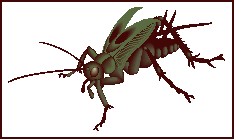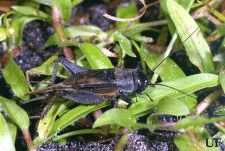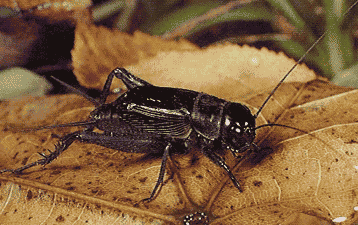|
HOME |
|

|
HOME |
|

What's that sound? It's a cricket! Are you aware of how a cricket makes music? Have you ever wondered why they were popular pets in China and Japan? Do you know how far a cricket can jump? Did you know they sing at night?
Adult crickets spend their days in shallow burrows beneath a stone, dirt or plant. They are most active during the night, and that is when males begin their music to attract female mates. Females don't stridulate, (that means to rub special body structures together to make a sound).
A male cricket has a heavy vein with
a row of teeth on the underside at the front of each wing.
The top of one wing was used as a scraper against the
underside of the other wing, like a fingernail drawn along
the teeth of a comb. This performance occurs with both wings
lifted so that the wing membranes can act as sounding
boards. The pitch of the chirps is slightly
higher than the highest octave on a piano. Air temperature
influences chirping rates; the warmer the night, the faster
they chirp. There are special songs for courtship, fighting,
and sounding an alarm.


Since crickets "chirp," you would suspect that they have some kind of "ear" to hear with, and they do. Crickets have a special eardrum for hearing, but it's not where you'd expect. If you look closely at the front leg right below the elbow, you will see a small pale spot that is the eardrum. It is not well known how good a cricket's hearing is, but you can imagine that it's good enough to hear the song of a potential mate.
A cricket's life begins as one of about 300 eggs a female lays in the soil during late summer and autumn. Some species overwinter successfully as nymphs or adults. Others overwinter as eggs and hatch in the Spring. A year-old cricket is a rarity. Crickets feed on just about anything. They will eat plants, dead insects, seeds, leather, paper and old cloth (especially if the cloth is stained by food or perspiration). They are particularly fond of wool and silk.
Crickets are able to jump up to twenty or thirty times their body length, which is about a metre into the air. Instead of getting a head start, they just stand still and take a big leap. This might seem like it would be hard to you, but to them, it is easy. They weigh much less than we do and their legs are built differently.
Generally, crickets are about 2 or 3cm long, with strong back legs and long antennae. They have wings, but rarely fly. They are good jumpers and use their legs as their main way to escape from predators. In fact, if a cricket is caught in a spider web, the spider takes great care to wrap webbing around it before moving in for the paralyzing bite. If the spider gets impatient, a swift kick from those powerful jumping legs could badly injure the spider.

Crickets were kept as pets in ancient China and Japan for their beautiful melodies. Crickets were prized as singing insects. Some crickets were kept in beautiful gold cages that only the rich could afford. Crickets were put in boxes in the bedroom so the owner could hear a nighttime serenade. For people who couldn't afford golden cages, wooden ones were made from trees and bamboo.
Did you know some people eat crickets? This lady is being offered some cricket brownies, but she doesn't look very keen on the idea. Would you taste a cricket brownie?
